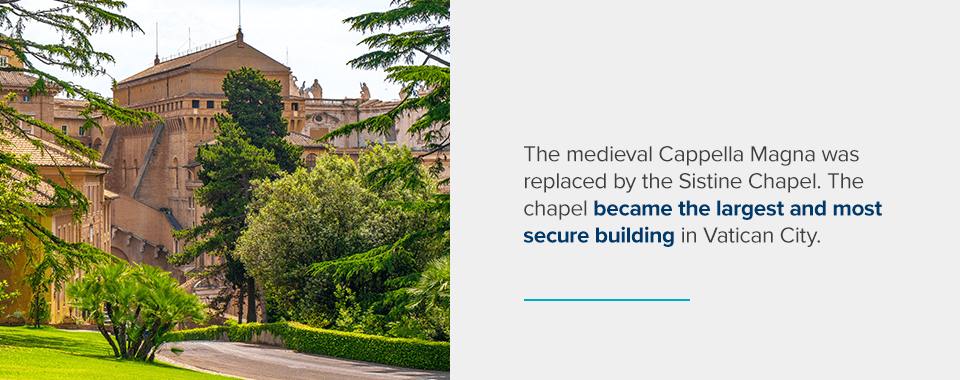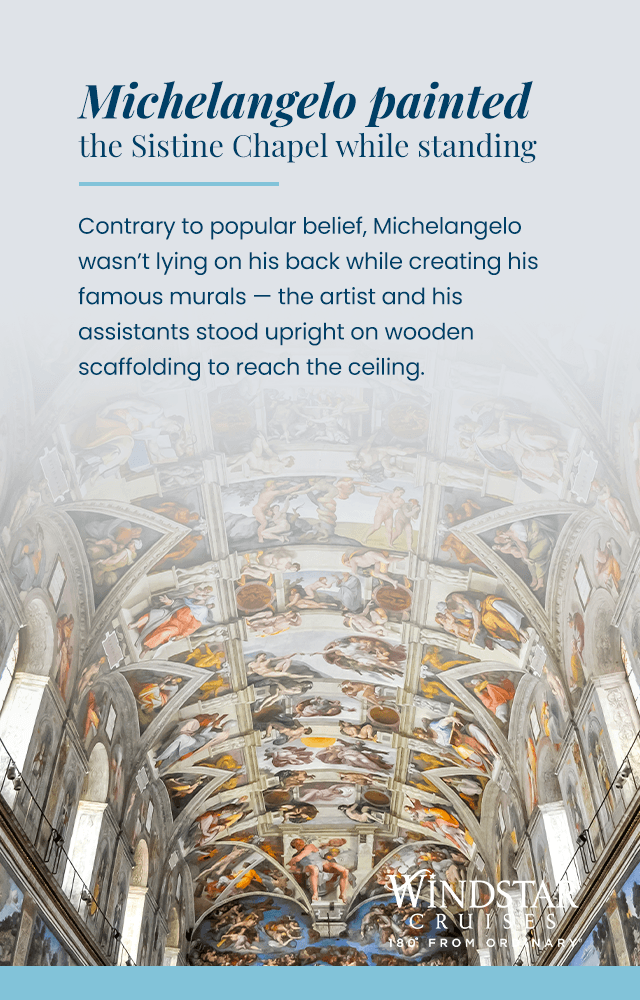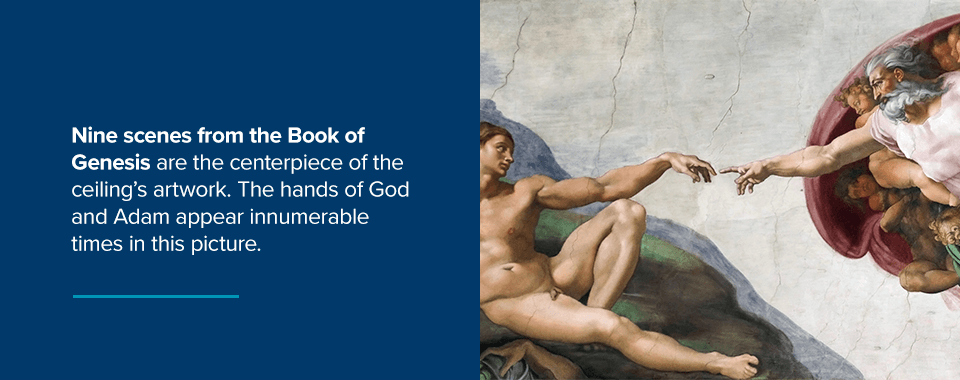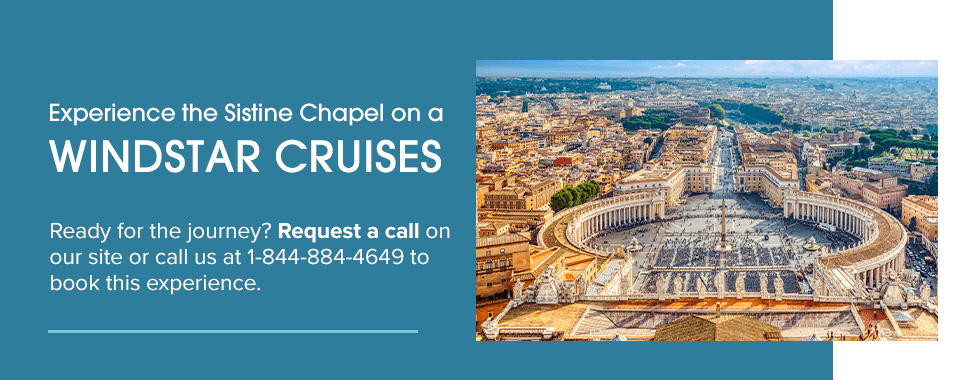
One of the chapels at the Apostolic Palace, where the pope’s formal residence is located, is the Sistine Chapel. The large chapel is located within the boundaries of the historical backdrop of Vatican City. It initially functioned similarly to the chapel in Vatican City, Cappella Magna.
One of Vatican City’s most cherished possessions is the Sistine Chapel. The chapel, famed for its extensive collection of Renaissance art, features some of the most famous frescoes created by some of the world’s most well-known Renaissance artists.
Pope Julius II commissioned the renowned Michelangelo Buonarroti to create the ceiling frescoes, generally known as the Sistine Ceiling, in 1508. The Sistine Chapel’s ceiling was finished by Michelangelo in 1512. High Renaissance art is best represented by Michelangelo’s fresco painting of the Sistine Chapel ceiling. Its significance to the development of art history cannot be emphasized enough. It eventually developed into a true academy for aspiring painters. This stance was solidified when Michelangelo returned to the chapel over 20 years later to paint the Last Judgment fresco on the altar wall.
The Sistine Chapel is among Rome’s most well-known and revered historical sites. It is situated inside Vatican City and Museums and receives roughly 25,000 visitors daily. It is a must-see during your trip to Rome. While cameras are banned at the chapel, the experience will remain embedded in your mind forever!
In This Article
- 1. The chapel has a plain exterior
- 2. The Sistine Chapel hosts the papal conclave
- 3. The Sistine Chapel was initially intended to serve as a Renaissance stronghold
- 4. The pope went into hiding from the French army while Michelangelo painted
- 5. Many other renowned artists are featured in the Sistine Chapel
- 6. The Sistine Chapel dimensions may have been inspired by Solomon’s Temple
- 7. Michelangelo painted the Sistine Chapel while standing
- 8. Michelangelo painted the Sistine Chapel in his early 30s
- 9. Michelangelo didn’t want to paint the ceiling
- 10. The ceiling was already painted before Michelangelo began his work
- 11. Michelangelo’s Sistine Chapel must be read east to west
- 12. Michelangelo worked backward
- 13. The ceiling displays a scene from the Book of Genesis
- 14. The Sistine’s most famous ceiling panel may depict a human brain
- 15. Michelangelo had to repaint his artwork a year later
- 16. Michelangelo had to destroy part of his ceiling 25 years later
- 17. The Sistine Ceiling underwent repairs and modifications in the 1980s and ’90s
- 18. Michelangelo’s works of art are pretty robust
- Experience the Sistine Chapel on a Windstar Cruise
18 Facts You Might Not Know About the Sistine Chapel
Here are 18 fascinating Sistine Chapel facts that many people don’t know:
1. The chapel has a plain exterior
The Sistine Chapel is a brick building with a barrel-vaulted ceiling and six arch-shaped windows on its two main sides. The chapel’s facade is bare and unadorned, despite the ceiling and internal walls being beautifully decorated with paintings and works of art by various Florentine Renaissance painters. Its most famous frescoes are the Michelangelo paintings on the chapel’s ceiling and the west wall behind the altar.
2. The Sistine Chapel hosts the papal conclave
The first papal conclave at the Sistine Chapel was in 1492, when cardinals convened to select a new pope. Fourteen of the 23 cardinals present at the conclave received elevation from Pope Sixtus IV. The “Sistine Cardinals” of Sixtus IV, commanded by Giuliano della Rovere, exercised complete control over the conclave of 1484, electing Giambattista Cibo as Pope Innocent VIII.
When white smoke is signaled from the chimney of the Sistine Chapel, it signifies that a new pope has been selected. Black smoke is signaled when no candidate has won a two-thirds majority.
3. The Sistine Chapel was initially intended to serve as a Renaissance stronghold
The Sistine Chapel is a stark, sizeable crenelated rectangle supported by solid buttresses and made of thick, plain brick walls. It resembles a medieval castle rather than one of the finest museums of Western art. There’s a good reason for this — Pope Sixtus IV wasn’t just looking for a sacred space where masses and significant ecclesiastical decisions could take place against the backdrop of beautiful works of art. He was actually concerned for his own safety!
It was a warring period, so the pope wanted his chapel to also serve as an impenetrable fortress within Vatican City in case of an attack. The medieval Cappella Magna was replaced by the Sistine Chapel. The chapel became the largest and most secure building in Vatican City.

4. The pope went into hiding from the French army while Michelangelo painted
Pope Julius II escaped to the Castel Sant’Angelo to hide from the French army, which was invading Rome, but Michelangelo continued to paint the Sistine ceiling for the pope. Pope Julius II gleefully cut off his beard and declared victory after the unexpected death of the French army’s general, Gaston de Foix, in combat.
5. Many other renowned artists are featured in the Sistine Chapel
The best painters from Tuscany and Umbria came to Rome, including Botticelli, Perugino and Ghirlandaio, who painted stunning murals depicting the lives of Moses and Jesus on the chapel’s side walls to participate in the initial decoration campaign.
Six murals by Cosimo Rosselli, Pinturicchio, Domenico Ghirlandaio, Perugino and Sandro Botticelli depict scenes from Christ’s life and are painted on the north wall. Six other murals depicting events in Moses’ life were created by Bartolomeo della Gatta, Pinturicchio, Domenico and Benedetto Ghirlandaio, Luca Signorelli, Botticelli, Rosselli and Perugino on the south wall.
Popes are shown in other small paintings above these artworks located between the windows. Along the lower side walls, tapestries depicting episodes from the Gospels and the Acts of the Apostles were hung during significant ceremonial occasions. These were woven in Brussels between 1515 and 1519 and were designed by Raphael.
6. The Sistine Chapel dimensions may have been inspired by Solomon’s Temple
Pope Sixtus IV desired a distinguished pedigree for his reign’s pinnacle achievement. He discovered it in a replica of the Temple of Solomon, constructed in Jerusalem in 966 B.C. and described in the Hebrew Book of Kings. The builds share some similarities — their lengths are three times their widths, and they’re both twice as long as they are tall.
In Perugino’s fresco of Christ handing the keys to St. Peter, the temple of Solomon is mentioned explicitly in an inscription, indicating the connection between the Sistine Chapel and the Temple of Solomon. Although Solomon’s Temple was adorned with two highly precious assets of the ancient world — cedar and gold — the Sistine Chapel is decorated with the most priceless intangible asset of the Renaissance — the painted masterpieces of the period’s finest artists.
7. Michelangelo painted the Sistine Chapel while standing
Contrary to popular belief, Michelangelo wasn’t lying on his back while creating his famous murals — the artist and his assistants stood upright on wooden scaffolding to reach the ceiling. Michelangelo himself arranged the odd configuration of platforms framed by the walls. The image that Michelangelo painted on his back might have been inspired by how Michelangelo’s ceiling was portrayed in the 1965 film “The Agony and the Ecstasy.”

8. Michelangelo painted the Sistine Chapel in his early 30s
Michelangelo already had an impressive reputation as a sculptor at this point. He worked on three other projects but was frequently interrupted and never completed them. His time painting the chapel was filled with disappointments, disputes, hesitations and interruptions from his coworkers and family.
The artist argued with the pope at one point, and soon after, he fled Rome in secret for Florence. The Florentine authorities requested that he return to the pope, so he left for Rome. By the time Michelangelo completed the fresco on the Sistine Ceiling, he was 37 years old.
9. Michelangelo didn’t want to paint the ceiling
Michelangelo was initially commissioned to work on the marble tomb of Pope Julius II at the Church of San Pietro in Vincoli. In 1508, Pope Julius II asked him to paint the Sistine Chapel’s ceiling instead. Michelangelo refused. To begin with, he had no prior knowledge of frescoes and considered himself a sculptor, not a painter. Furthermore, despite the declining financial support for the tomb project, he was determined to finish the job.
However, Michelangelo grudgingly accepted this significant color project and painted for the following four years. He occasionally returned to the pope’s massive mausoleum during the four decades.
10. The ceiling was already painted before Michelangelo began his work
The Sistine Ceiling had been ornamented before Michelangelo began work on it. A fresco by Umbrian artist Pier Matteo d’Amelia depicted a blue night sky with glittering stars. Pope Julius II had the fantastic notion of painting the Sistine Ceiling two years before Michelangelo began.
The three floors’ bottom wall was painted to resemble hanging drapes. Raphael’s tapestries are still hung on special occasions. On the right side of the middle level of the wall is a fresco that depicts the life of Christ and on the left is a fresco that depicts the life of Moses.
11. Michelangelo’s Sistine Chapel must be read east to west
The creation tale’s first scene begins above the altar at the chapel’s east end. The clergy members perform the eucharistic rites in that area. A modest rectangular field depicting the initial act of creation sits directly above the altar. The nine central places highlighting Noah’s inebriation are toward the west end. This scene is located by the laity’s entrance. It stands for the corrupt essence of man.
12. Michelangelo worked backward
In the spring of 1508, Michelangelo started painting the Sistine Ceiling. He began at the western end with Noah and the Prophet Zechariah’s inebriation. He ended with Eve’s creation in the fifth bay of the vault after working backward. He completed the painting on August 1511. He took a little pause from painting while they constructed the scaffolding he utilized and resumed working on the painting’s second section before completing it a year later.
13. The ceiling displays a scene from the Book of Genesis
Nine scenes from the Book of Genesis are the centerpiece of the ceiling’s artwork. One is the well-known Creation of Adam, which numerous art critics have linked to the Mona Lisa by Leonardo da Vinci. The hands of God and Adam appear innumerable times in this picture. This image consists of intricate decorations with numerous distinct dressed and bare individuals. Through this painting, Michelangelo was able to demonstrate his abilities. He developed many positions for the human figure that later gained popularity.

14. The Sistine’s most famous ceiling panel may depict a human brain
The Creation of Adam features images of God and Adam reaching out to touch one another. Their fingertips are almost touching in one of the most recognizable and widely reprinted images in the entire world. Some theorists claim that the angels and clothing surrounding God form the outline of a human brain.
Doctor Frank Lynn Meshberger theorized that Michelangelo implied that God gave the first man the gift of intelligence. God was Michelangelo’s last subject because he wanted to perfect his technique before painting Him. Christian art and depictions of God have been modeled after this image of God as an elderly man with long gray hair.
15. Michelangelo had to repaint his artwork a year later
A sizable portion of Michelangelo’s illustrations started molding a year after completing the ceiling. Michelangelo had been working on the walls of the pope’s library when the pope asked him to repaint the ceiling. Michelangelo tried to argue that the molding was evidence of his lack of knowledge as a painter. However, the pope refused and insisted that Michelangelo repaint the ceiling! The specific section of the wall that was repainted has held since then, and the fresco’s repaint is hardly noticeable.
16. Michelangelo had to destroy part of his ceiling 25 years later
A new pope, Clement VII, asked Michelangelo to return to the Sistine Chapel when the artist was roughly 60 years old and paint The Last Judgement on the altar wall. However, to create a new painting, he first had to remove two lunettes that showed the Ancestors of Christ.
17. The Sistine Ceiling underwent repairs and modifications in the 1980s and ’90s
Between 1980 and 1999, a few Sistine Chapel artworks, including Michelangelo’s well-known The Last Judgment fresco, underwent expert restoration. Layers of dust and soot were painstakingly removed by experts, greatly enhancing the colors of the old paintings. The repair work undid Pope Pius IV’s instruction in the 1560s to use loincloths and fig leaves to cover the nude illustrations, as well.
18. Michelangelo’s works of art are pretty robust
The Sistine ceiling has miraculously lasted over five centuries! Only a tiny section of the sky is missing from the panel portraying Noah’s escape from the massive biblical flood. A painted plaster broke and fell to the floor in 1797 after an explosion at a gunpowder warehouse close by. Despite the ceiling’s appearance of robustness, experts are concerned that the millions of tourists visiting the chapel every year pose a threat.
Experience the Sistine Chapel on a Windstar Cruise
Experience some of the finest Renaissance art and the rich history of Italy and Vatican City with Windstar Cruises. We provide the ultimate comfort and elegance. Our ships offer the space and independence you need to escape large crowds and truly enjoy your travels. Take full advantage of our stop at Vatican City to learn all about the fascinating history of the Sistine Chapel.
While you’re there, explore Italy’s capital with a trip to the Colosseum, Rome’s most iconic monument! Enjoy hearty Chianti wines and freshly cooked pasta dishes in the welcoming atmosphere of a neighborhood Italian restaurant. Ready for the journey? Request a call on our site or call us at 1-844-884-4649 to book this experience.




















































